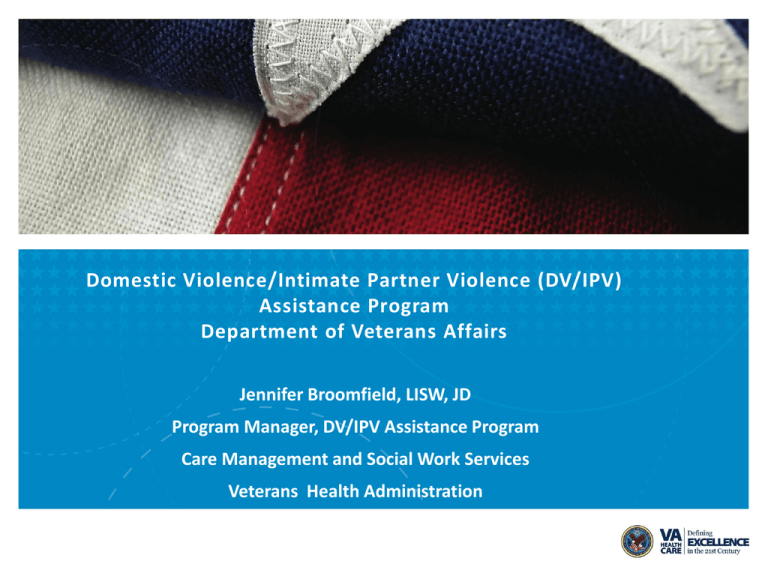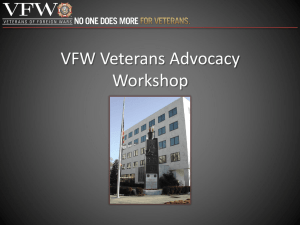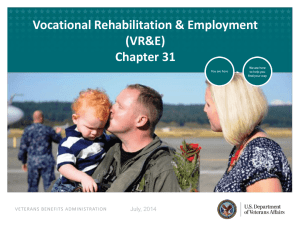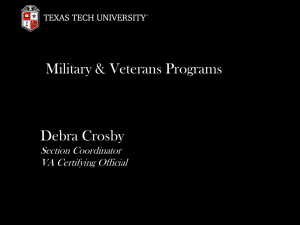DV/IPV - Justice for Vets
advertisement

Domestic Violence/Intimate Partner Violence (DV/IPV) Assistance Program Department of Veterans Affairs Jennifer Broomfield, LISW, JD Program Manager, DV/IPV Assistance Program Care Management and Social Work Services Veterans Health Administration Agenda • • • • • • • • Development of Domestic Violence/Intimate Partner Violence (DV/IPV) Assistance Program – Task Force – Plan for Implementation of the Domestic Violence/Intimate Partner Violence Assistance Program Key Recommendations Initial Implementation Strategies Network Points of Contact (POCs) / Domestic Violence Coordinator (DVCs) Roles & Responsibilities Screening for DV/IPV Developing a DV/IPV Community of Practice DV/IPV Resources Q&A VETERANS HEALTH ADMINISTRATION 2 Objectives • Learn about the National Domestic Violence/Intimate Partner Violence (DV/IPV) Assistance Program. • Be able to identify the key recommendations of the DV/IPV Task Force. • Understand the roles of the Domestic Violence Coordinators (DVCs)/Network Points of Contact (POCs). • Identify why screening is important and identify effective screening procedures. • Examine the role a Community of Practice can play in offering DV/IPV Assistance Program services. VETERANS HEALTH ADMINISTRATION 3 Task Force Definitions of Domestic Violence and Intimate Partner Violence • Domestic violence: Though this term has historically referred to intimate partner violence, it more accurately refers to any violence or abuse that occurs within the “domestic sphere” or “at home,” and may include child abuse, elder abuse, and other types of interpersonal violence (Wallace 2004). • Intimate Partner Violence: “The term intimate partner violence describes physical, sexual, or psychological harm or stalking behavior by a current or former partner that occurs on a continuum of frequency and severity ranging from emotional abuse to chronic, severe battering or even death. It can occur in heterosexual or same-sex relationships and does not require sexual intimacy or cohabitation” (CDC 2012). VETERANS HEALTH ADMINISTRATION 4 DV/IPV Task Force and Plan for Implementation • In May 2012, VA chartered the DV/IPV Task Force to develop a national program. • The VHA Plan for Implementation of the DV/IPV Assistance Program was finalized December 2013. • Plan includes 14 recommendations. • Implementation of the plan across the VHA will expand screening, prevention and intervention to Veterans and will strengthen partnerships with community providers/resources. • Focus is on developing a culture of safety and adopting a holistic, Veteran-centered psychosocial rehabilitation framework to inform all facets of the national DV/IPV assistance program: – “Veterans who experience DV/IPV” vs. “Victim” or “Survivor” – “Veterans who use DV/IPV” vs. “Batterer” or “Abuser” VETERANS HEALTH ADMINISTRATION 5 Key Actions for Implementation • Assign Points of Contact (POCs) at Veteran Integrated Service Network (VISN) level. • Assign local Domestic Violence Coordinators (DVCs) for each Veterans Affairs Medical Center (VAMC). • Develop a National Awareness/Education Campaign and Communication Plan. • Develop and deliver training on risk identification and intervention across the VA (including Employee Assistance Program/Employee Health Staff). • Implement safety assessment/planning and referral process for Veterans who screen positive for experiencing DV/IPV. VETERANS HEALTH ADMINISTRATION 6 Key Actions for Implementation (continued) • Establish network of national and local community partnerships. • Partner with a hotline for crisis and prevention calls. • Implement Veteran-centered services for Veterans who experience DV/IPV. • Integrate DV/IPV Assistance Program into Workplace Violence Prevention Programs. • Implement pilot screening and treatment programs for Veterans who use violence. VETERANS HEALTH ADMINISTRATION 7 Pilot Treatment Programs for Veterans Who Use Violence • The Plan recommends piloting (in several clinical settings that have existing capability to provide intervention programs and services for Veterans who use DV/IPV) two treatment programs for Veterans identified as using violence in current or former intimate relationships. • Strength at Home “Men’s Program” (Dr. Casey Taft) • ̶ Cognitive behavioral, trauma-informed group treatment. ̶ Enhancing motivation for change and skill building. ̶ Psychoeducation and anger management. Contextual Intimate Partner Violence Therapy (CIPVT) (Dr. Rachel Latta) – Recovery oriented, strengths-based individual, couples and group treatment. – Focus on healthy relationships. – Increase healthy coping strategies and reduce negative strategies. VETERANS HEALTH ADMINISTRATION 8 Initial Implementation Strategies • National DV/IPV Program Manager appointed. • Establish DV/IPV Steering Committee. • Identify Network POCs and Facility DVCs. • Develop and implement use of a screening tool. • Develop training materials for national roll out. • Establish community partnerships with DV experts/agencies. VETERANS HEALTH ADMINISTRATION 9 Network POCs Roles & Responsibilities • Ensure that National DV/IPV policies and procedures are implemented at the local level. • Support and serve as consultant to the local DVCs. • Liaison to the National DV/IPV Program Manager. VETERANS HEALTH ADMINISTRATION 10 DVCs Roles & Responsibilities • • • • • • • • • Coordinate DV/IPV training for Medical Center staff. Provide information and assistance to Veterans and their families. Coordinate assessment, safety planning and intervention/treatment for Veterans who screen positive for experience/use of DV/IPV and who accept a referral to the DVC. As appropriate, coordinate referrals for non-Veteran partners of Veterans. Monitor screening, referral and treatment data. Develop relationships with community providers. Train community partners. Maintain and disseminate current list of community resources. Meet National Program reporting requirements. VETERANS HEALTH ADMINISTRATION 11 Why Screening for Experience of DV/IPV is important • • Prevalence of DV/IPV Impact of DV/IPV on mental and physical health outcomes – Mental Health issues: Depression, substance use, suicide (de Boinville 2013) • Healthcare settings particularly lend themselves to screening for DV/IPV – Patients are usually seen individually. (de Boinville 2103) – Providers can discuss abuse and violence in the context of health care to help patients understand the connection between abuse and their physical/mental health and wellbeing. (de Boinville 2013) – Patients believe healthcare providers should screen for DV/IPV. (Burge et al 2005) VETERANS HEALTH ADMINISTRATION 12 Women’s Veterans Preferences for Screening • • • • • • • • Women Veterans generally support screening for DV/IPV. Give Veteran a choice about what, when, to whom, and how to disclose. Provide follow-up support. Ask permission before documenting IPV in healthcare record. Providers should be knowledgeable about VA and community resources. Offer a “head-ups” before beginning the screen. Avoid clinical terms. Be present and “tuned-in.” From Iverson et al. (in press) Women veterans’ preferences for intimate partner violence screening and response procedures within the Veterans Health Administration. VETERANS HEALTH ADMINISTRATION 13 SAFER – Screening Protocol • • • • • Screen with E-HITS Acknowledge and validate Focus on safety using danger assessment items Educate Referral and documentation options SAFER Protocol developed by VHA DV/IPV Assistance Program Pilot Project Team VETERANS HEALTH ADMINISTRATION 14 E-HITS Screening Tool • • The DV/IPV Assistance Program recommends use of the E-HITS Screening tool to assess for the presence of DV/IPV. The Tool consists of 5 questions: – H: Has your partner ever physically hurt you in the past 12 months? – I: Has your partner ever insulted you in the past 12 months? – T: Has your partner ever threatened to harm you in the past 12 months? – S: Has your partner ever screamed or cursed at you in the past 12 months? – Extended: Has your partner ever forced you to have sexual activities in the past 12 months? The Veteran is asked to respond to each of the above questions with one of the following: – 1. Never – 2. Rarely – 3. Sometimes – 4. Often – 5. Frequently HITS copyrighted in 2003 by Kevin Sherin MD, MPH. VHA has obtained permission to use E-HITS internally for non-profit purposes. Please seek permission from Dr. Sherin (kevin_sherin@doh.state.fl.us) before use. VETERANS HEALTH ADMINISTRATION 15 Communities of Practice • • “A community of practice is a group of people who share a concern or a passion for something they do, and learn how to do it better as they interact regularly.” (Wenger-Trayner 2014). “A community of practice is held together by the ‘learning value’ members find in their interactions. They may perform tasks together, but these tasks do not define the community. It is the ongoing learning that sustains their mutual commitment. Members may come from different organizations or perspectives, but it is their engagement as individual learners that is the most salient aspect of their participation. The trust members develop is based on their ability to learn together: to care about the domain, to respect each other as practitioners, to expose their questions and challenges, and to provide responses that reflect practical experience” (Wenger-Trayner 2014). VETERANS HEALTH ADMINISTRATION 16 DV/IPV Communities of Practice • How can a Community of Practice assist us in serving Veterans who experience or use DV/IPV? – Relationships and networks. – Increase knowledge via case based learning and multi-disciplinary information exchange. – Opportunity for reflective practice. (Kings College London 2013). From: Hennessy, C. et al., (2013). Toolkit: Developing a Community of Practice. VETERANS HEALTH ADMINISTRATION 17 Developing a DV/IPV Community of Practice • Inquire (Who? Purpose? Goals? Vision?). • Design (Activities/technologies/group processes/roles). • Prototype (pilot the community of practice with key stakeholders). • Launch (Roll out the community to a broader audience over time). • Grow (Collaborative learning and knowledge sharing activities). From: Cambridge et al., (2005) Community of Practice Design Guide. VETERANS HEALTH ADMINISTRATION 18 Key DV/IPV Community of Practice Members • • • • • • • • • • • • VA Staff (DVC, VJO, Homeless Program, Mental Health, Women’s Health, Primary Care, OEF/OIF/OND, Caregiver Support Program, Health Services Research & Development, VBA Point of Contact) Domestic Violence Shelter Homeless Shelters Community Domestic Violence Counseling Programs Supervised Visitation Programs Local DV Coalition Intervention Programs Treating Individuals Who Use DV/IPV Legal Aid Office of District Attorney/State Attorney Law Enforcement Child Welfare State/County Health and Human Services/Entitlements Programs VETERANS HEALTH ADMINISTRATION 19 Web Links to learn more about DV/IPV • • • Centers for Disease Control: http://www.cdc.gov/violenceprevention/intimatepartnerviolence/index.html Futures without Violence: http://www.futureswithoutviolence.org/ Motivational Interviewing with Individuals Experiencing IPV: – – – • • http://www.youtube.com/watch?v=P3JUXQ4kkHs&list=PL5A76222400692548&index=2 http://www.youtube.com/watch?v=lrnkEQRUyJM&index=3&list=PL5A76222400692548 http://www.youtube.com/watch?v=jxNBQKMW1wg&index=4&list=PL5A76222400692548 National Domestic Violence Hotline: http://www.thehotline.org/ (this website also lists contact information for State Coalitions and LGBT resources). Simmons College – School of Social Work Self-Paced Domestic Violence Training: – http://www.simmons.edu/ssw/academics/professional/online/domestic-violencetraining/index.php • Veterans Affairs – Women Veterans Health Care: http://www.womenshealth.va.gov/WOMENSHEALTH/outreachmaterials/abuseandviolence /intimatepartnerviolence.asp VETERANS HEALTH ADMINISTRATION 20 References • • • • • Burge S. et al., (2005) Patients’ Advice to Physicians About Intervening in Family Conflict, Annals of Family Medicine, (3), 248-54. Cambridge D. et al., (2005). Community of Practice Design Guide Retrieved 2014, March 11 from http://net.educause.edu/ir/library/pdf/nli0531.pdf Centers for Disease Control and Prevention (2014, March 11). Intimate Partner Violence: Definitions. Retrieved from http://www.cdc.gov/violenceprevention/intimatepartnerviolence/definitions.html Chan et al., (2010) Reliability and Validity of the “Extended – Hurt, Insult, Threaten, Scream (E-HITS)” Screening Tool in Detecting Intimate Partner Violence in Hospital Emergency Departments in Hong Kong. Retrieved from http://www.hkcem.com/html/publications/Journal/2010-2/p109-117.pdf De Boinville, M., (2013) APSE Policy Brief: Screenings for Domestic Violence in Health Care Settings. Retrieved from http://aspe.hhs.gov/hsp/13/dv/pb_screeningdomestic.cfm VETERANS HEALTH ADMINISTRATION 21 References (cont’d) • • • • • Hennessy, C. et al., (2013). Toolkit: Developing a Community of Practice. Kings College London. Retrieved 2014, March 11 from http://www.revolvingdoors.org.uk/documents/toolkit-for-developing-a-community-of-practice/ Iverson, K. M., King, M. W., Resick, P. A., Gerber, M. R., Kimerling, R., & Vogt, D. (2013). Clinical utility of an intimate partner violence screening tool for female VHA patients. Journal of General Internal Medicine, 28, 1288-1293 Iverson, K. M., Huang, K., Wells, S. Y., Wright, J., Gerber, M. R., & Wiltsey-Stirman, S. (in press). Women veterans’ preferences for intimate partner violence screening and response procedures within the Veterans Health Administration. Research in Nursing & Health. Wallace, H. (2004). Family Violence: Legal, Medical and Social Perspectives. Allyn & Bacon. Wenger-Trayner Website (2014 March 11) Retrieved from http://wengertrayner.com/resources/what-is-a-community-of-practice VETERANS HEALTH ADMINISTRATION 22 Q&A / Contact Information • • • Questions? Jennifer.Broomfield@va.gov 202-461-0254 VETERANS HEALTH ADMINISTRATION 23







